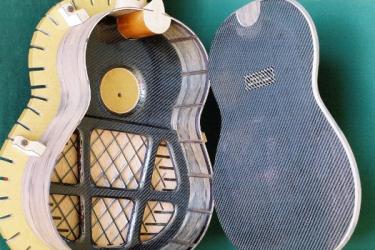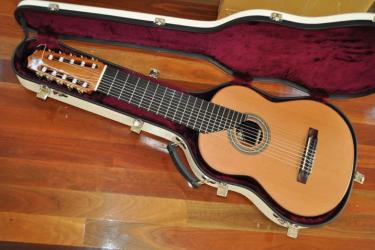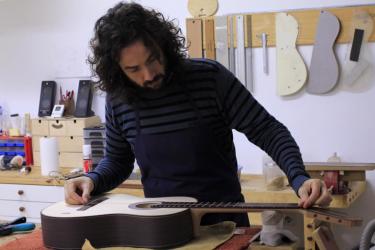I’m delighted to have Juan Álvarez from Madrid, Spain.
Q1. Could you please tell us a little about your luthiery and its history?
My father, Juan Álvarez I, started the guitar making in 1945, with his brother Lorenzo. Both were instructed by Marcelo Barbero.
I started to learn how to make guitars from my father in 1977, and my brother Antonio Álvarez, whom my father always considered the best of all three, joined us two years later. Unfortunately, he gave it up three years after to take other jobs up.
My early days were difficult, I was studying at the University while I was working at the workshop, my father was a man of the other generation, his teaching method was based on a extreme strictness.
Juan Álvarez I got retired in 1977 and passed away in 2001. I have been keeping up the luthier of this brand in "San Pedro street" since early 60's.
Q2. Please describe your idea of a good sounding guitar, and what you do to achieve it?
Nowadays the preference of the sound is changing. People look for a guitar that produces more explosive and aggressive sound than the sound of the guitars l learned from my father.
Of course, I adapted myself to the dominant trend. However, I still keep trying to make guitars that give you the enjoyment of their sweet and characteristic taste that the Madrid school have been offering.
To achieve the sound I have tried to describe above depends on the total balance and every single part of the guitar, which is a very different concept from the one that existed some years ago; the only crucial part was the top.
Q3. Please tell us about your idea of improving playability, and what you do to achieve it?
Surely, the main concept of it is that guitarists find it comfortable to play from the very first moment, and that they can play for long hours without getting tired. To achieve it, I pay special attention to the shape, measure, and angles of the neck.
Q4. Please tell us your opinion about the traditional finishing method (French polish) and new methods (lacquer, catalysed finishing, etc).
Currently, I am using French polish for most of my guitars because of the new sound I talked about.
The synthetic varnish is not only more resistant but also gives the guitar sweeter tone, which was the characteristic sound of the Madrid school in the middle of 1960 to 1990, but the trend is different now.
Q5. Please tell us your opinion regarding shorter-scale guitars such as 640, 628 and 615mm in terms of playability, design, sound quality and volume. Is there an increasing need to cater to smaller-handed or female players?
I occasionally make short-scale guitars when I am commissioned to be exported or for women.
But, the shortening causes some lacking in sound quality. If it's not completely necessary, nobody asks me to make guitars with those scales. At present, I don't think the demands of short-scale guitars reach 2% of all the commissions.
Q6. Many readers say they end up being very confused after trying many guitars. Could you give us some advice on how to examine the guitars' sound quality and playability at a shop or luthier, from the guitar-maker's point of view?
Here, I won't be very useful.
The only advice I could give you would be that you try the guitar without anything else to distract you, i.e. firstly, consider the instrument itself, rather than any other outside factors, like verifying value etc. Play it for as long as you need (I absolutely don't mind how long people stay at my workshop trying the guitars as long as they don't test my guitars cruelly. In some occasions, I have seen guitarists attacking the strings in a brutal way until they achieved to make them sound like "the mistral". But the guitars never should be played in that way.
One of the other mistakes is to verify the value of a guitar by doing "magical" tests; the theory that if a given note played at a specific fret sounds in a specific way, it is an indication of a good guitar, forgetting the rest of notes on the fingerboard. I honesty believe these theories are not more than a superstition and wishes to be free from testing the guitar in depth.
Again, I think the best way is to test the guitar in depth for as long as needed, and let our body and mind feel the emotion. Such things as signs or magical notes that help us discover the potential of a guitar in ten seconds don't exist. Taking the guitar beyond the limits which the guitar is played doesn't reveal anything either.
Q7. Do you offer any 'after-sales' service to customers - particularly customers who are nervous about making a substantial investment?
Of course, I offer a complete guarantee. Something indicative of, and I'm always proud of, is that you can hardly find guitars made by me on the second-hand market. I like to think that all those who bought my guitars don't want to part with them.
Q8. How does the increasing rarity of some woods, rosewood for example, impact on your methods, and the quality of the end product?
Not at all. I have still timbers in stock and my technique can make up for the effect caused by the different classes of woods.
Q9. How do you see the future of this beautiful tradition in the 21st century?
I hope and believe that it is going to be fine. Of corse, there will be swerves caused by trends. However, I don't think even a minuscule part of the pleasure that the guitar making always has given to me and to all of the rest of my colleagues, is going to be lost.




